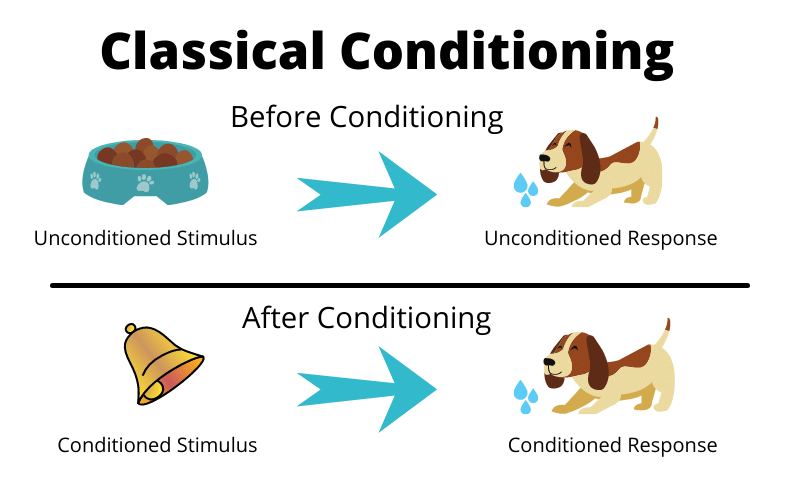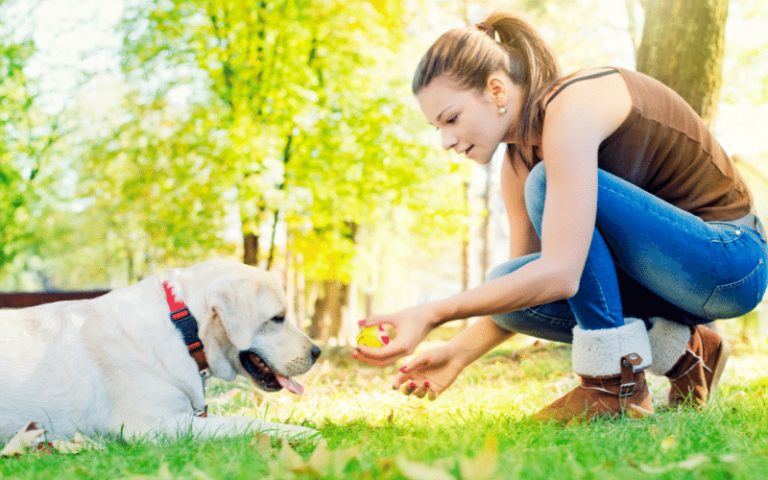Examples of Classical Conditioning
Classical conditioning is a learning process in which a neutral stimulus is paired with another stimulus that naturally produces a response. After repeated pairing, the previously neutral stimulus begins to evoke the response all on its own. Examples of classical conditioning include Pavlov’s experiment with dogs salivating at the sound of a bell and fear…

Classical conditioning is a learning process in which a neutral stimulus is paired with another stimulus that naturally produces a response. After repeated pairing, the previously neutral stimulus begins to evoke the response all on its own.
Examples of classical conditioning include Pavlov’s experiment with dogs salivating at the sound of a bell and fear responses in humans triggered by certain stimuli after being paired with a negative event.
Classical conditioning is a type of associative learning that takes place unconsciously. It works by associating one stimulus with something that already leads to a response. After an association is formed, the new stimulus will produce the same response.
The process was first described by a Russian physiologist named Ivan Pavlov. He discovered classical conditioning during his research on the digestive systems of dogs.
In this article, learn more about classical conditioning, how it works, and the different factors that can affect this learning process.
How Classical Conditioning Was Discovered
One of the most famous examples of classical conditioning is Pavlov’s experiments with dogs, which first led to the discovery of this type of learning. Ivan Pavlov’s experiments with dogs were among the most famous psychological experiments ever performed. While studying dogs’ digestive systems, Pavlov noticed the animals in his experiment salivated whenever they saw the lab assistants who fed them.
To learn more, Pavlov began ringing a bell whenever the dogs were fed. Eventually, an association formed between the sound of the bell and the presentation of food, and the dogs began to salivate whenever they heard the sound of the bell.
Pavlov’s discovery played a significant role in developing the school of thought known as behaviorism and influenced the work of other thinkers, including John B. Watson and B. F. Skinner.
Watson conducted an influential experiment on fear conditioning, while Skinner developed another learning theory known as operant conditioning.
How Classical Conditioning Works
To understand how classical conditioning works, it is important to learn a bit more about the different components of the process. The following are examples of classical conditioning terms that you should understand:
Unconditioned Stimulus (UCS)
This is the stimulus that automatically and naturally triggers a response or behavior. In Pavlov’s experiments, food was the unconditioned stimulus.
Conditioned Stimulus (CS)
This is the previously neutral stimulus that evokes a response after being paired with the unconditioned stimulus. In Pavlov’s experiment, the sound of the bell was the conditioned stimulus.
Unconditioned Response (UCR)
This automatic response occurs when presented with an unconditioned stimulus. In Pavlov’s experiment, salivating in response to food was the unconditioned response.
Conditioned Response (CS)
This response occurs when the conditioned stimulus is presented. In Pavlov’s experiment, the dogs salivating when they heard the bell was the conditioned response.
The Classical Conditioning Process
Before you explore examples of classical conditioning, it’s essential to understand how the process works. There are three basic steps in the conditioning process:
Before Classical Conditioning
Prior to any conditioning taking place, the natural stimulus simply evokes the unconditioned response whenever it is presented. No learning is needed for this to take place.
During Classical Conditioning
In order to form an association, a neutral stimulus is repeatedly paired with the unconditioned stimulus. The timing of this presentation can have an effect on the efficacy and strength of the conditioning:
Delay Conditioning
The conditioned stimulus is presented immediately before the unconditioned stimulus so that its presentation overlaps. For example, a loud ring might occur right before a mild electrical shock, but the ring would still be heard as the shock was delivered.
Trace Conditioning
Sometimes, the conditioned stimulus will be presented, followed by a short interval before the unconditioned stimulus is presented. There is no overlap between the presentation of the conditioned stimulus and the presentation of the unconditioned stimulus.
Simultaneous Conditioning
The conditioned stimulus and unconditioned stimulus may be presented at precisely the same time.
Once the association is formed, the previously neutral stimulus becomes known as the conditioned stimulus.
After Conditioning
In this stage of the process, the conditioned stimulus can be presented on its own without the unconditioned stimulus, and it will trigger the response (now known as the conditioned response) all on its own.
Examples of Classical Conditioning Principles
There are also some other essential aspects of associative learning that can occur at different phases of the process. These include:
Acquisition
Acquisition occurs in the early stages of learning in which the neutral stimulus is repeatedly paired with the conditioned stimulus. A response has been acquired once the conditioned stimulus comes to evoke the conditioned response.
Extinction
Conditioned responses don’t always stick around. The conditioned response may eventually fade or disappear if a conditioned stimulus is no longer paired with an unconditioned stimulus through a process known as extinction.
Stimulus Discrimination
Stimulus discrimination involves the ability to distinguish between two or more similar stimuli and only respond to the conditioned stimulus.
Stimulus Generalization
Stimulus generalization occurs when stimuli similar to the conditioned stimulus also trigger the conditioned response. In the famous Little Albert experiment, a child was conditioned to fear a white rat; however, that fear also generalized to other furry, white objects.
Spontaneous Recovery
Spontaneous recovery involves the sudden reappearance of a previously conditioned response. If a conditioned response has disappeared, it might suddenly reappear after the presentation of the conditioned stimulus. However, the response will be quickly lost if the conditioned and unconditioned stimuli are no longer paired.
Examples of Classical Conditioning in Real Life
You can see more about how this process works by looking at some real examples of how classical conditioning has been used.
Example 1: Fear and Phobias
Classical conditioning can play a role in the development of fear responses. In the Little Albert experiment, for example, researchers repeatedly paired a loud noise with the sight of a white rat. This association caused the little boy in the experiment to become fearful of the rat.
This same process can explain how some phobias form. In the cases of phobias, these associations often form after a single pairing of the conditioned stimulus and the unconditioned stimulus. For example, the sight of a needle paired with the sharp pinch of pain caused by injection might cause a child to become afraid of needles.
Example 2: Phone Notifications
Classical conditioning can also explain why you might feel compelled to check your phone for notifications. Because checking your phone is repeatedly associated with finding information that meets your need for knowledge and connection, you develop an association between the sound of a phone notification and checking your phone.
Because of this, you probably even reflexively check your phone when you hear someone else’s phone chime.
Example 3: Advertising
Marketers also use classical conditioning in advertisements. They do this by creating associations between the products they are trying to sell with things that already have pleasant associations in your mind.
For example, marketers might pair their product with a beautiful location, an athlete you admire, a beautiful model, or a celebrity you like.
Example 4: Taste Aversions
In a series of experiments, psychologist James Garcia utilized aversive conditioning by pairing neutral stimuli—including sweetened water, noise, and light—with feelings of nausea. Animal subjects that drank the sweetened weather before becoming nauseated would not drink the water again. However, the other neutral stimuli did not lead to the same avoidance.
According to Garcia, this demonstrated the concept of biological preparedness. In other words, people and animals are more likely to form specific associations because they aid in our survival. Associating food with the onset of illness might protect an animal from eating something dangerous.
Examples of Classical Conditioning Uses
Classical conditioning can have various applications in real life, including in education and mental health.
Behavioral Therapy
Classical conditioning is the basis for several effective behavioral therapy treatment options, including flooding, systematic desensitization, and aversion therapy. These approaches are known as counterconditioning because they help replace an unwanted response to a stimulus with a more positive one.
Flooding
Flooding involves exposing someone to a high intensity of their fear. When their response, or the feelings of anxiety and fear, is not reinforced, the association between the source is the fear and the anxiety response begins to weaken.
Aversion Therapy
Aversion therapy creates an association between a behavior and an unpleasant outcome. For example, pairing alcohol with feelings of nausea is an aversion therapy that may be used to reduce or eliminate alcohol consumption.
Systematic Desensitization
Systematic desensitization is often used to de-condition fears and phobias. People are gradually exposed to what they fear, paired with relaxation techniques. Over time, an association is formed between the stimulus and the feelings of relaxation, which helps reduce fear.
Behavioral treatments that utilize classical conditioning may be used to treat anxiety, phobias, and substance use disorders, among other things.
Education
Educators may sometimes utilize principles of classical conditioning in the classroom. For example, teachers may create a pleasant, positive classroom setting to help children form positive associations that can help make learning more enjoyable.
Examples of Classical Conditioning Study Questions
What are the four principles of classical conditioning?
Four important principles that affect the classical conditioning process are:
- Stimulus generalization
- Stimulus discrimination
- Extinction
- Spontaneous recovery
What Are the five components of classical conditioning?
The five components that make up classical conditioning are:
- The neutral stimulus
- The unconditioned stimulus (UCS)
- The conditioned stimulus (CS)
- The unconditioned response (UCR)
- The conditioned response (CR)
How can teachers use classical conditioning to help students?
Pairing schoolwork with a pleasant classroom environment can help create positive associations between school and learning.
What is the definition of learning?
Psychologists define learning as a process in which new knowledge, attitudes, behaviors, or ideas or acquired. It can occur in a variety of ways, including unconsciously and unconsciously. Classical conditioning is an unconscious form of learning.
What are some other names for classical conditioning?
Classical conditioning is also sometimes referred to as Pavlovian conditioning or respondent conditioning.
How do you distinguish between an unconditioned stimulus and a conditioned stimulus?
An unconditioned stimulus produces a response automatically without any prior learning. A conditioned stimulus was previously a neutral stimulus that was first associated with the UCS to produce a response.
How do you distinguish between the unconditioned response and the conditioned response?
The unconditioned response occurs naturally and automatically in response to the unconditioned stimulus. The conditioned response occurs due to learning in response to the conditioned stimulus.
What are the benefits of classical conditioning?
Classical conditioning can be used to help people learn positive behaviors or to eliminate unwanted behaviors. For example, in behavioral therapy, people can learn to associate feelings of relaxation with situations that previously created anxiety. Once that association is acquired, they will feel less distressed and anxious in those situations.
Summary
Classical conditioning is an unconscious learning process that can significantly influence human behavior, motivation, emotion, and well-being. It can be utilized in ways to help people learn new behaviors and overcome problematic behaviors. It can also be used in less ideal ways, such as in marketing to influence people to engage in certain consumer behaviors.
Sources:
Balsam P. Relative time in trace conditioning. Annals of the New York Academy of Sciences. 1984;423(1):211-227. doi:10.1111/j.1749-6632.1984.tb23432.x
Garcia J, Ervin FR, Koelling RA. Learning with prolonged delay of reinforcement. Psychon Sci. 1966;5(3):121-122. doi:10.3758/BF03328311
Rehman I, Mahabadi N, Sanvictores T, Rehman CI. Classical conditioning. In StatPearls. StatPearls Publishing; 2022.





